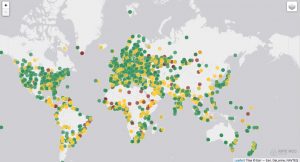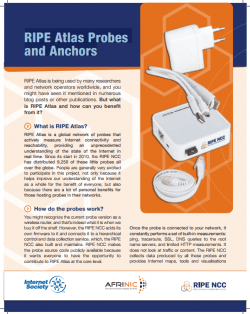RIPE Atlas is being used by many researchers and network operators worldwide, and you might have seen it mentioned in numerous blog posts or other publications. But what is RIPE Atlas and how can you benefit from it?
What is RIPE Atlas?
RIPE Atlas is a global network of probes that actively measure Internet connectivity and reachability, providing an unprecedented understanding of the state of the Internet in real time. Since its start in 2010, the RIPE NCC has distributed 9,250 of these little probes all over the globe. People are generally very excited to participate in this project, not only because it helps improve our understanding of the Internet as a whole for the benefit of everyone, but also because there are a lot of personal benefits for those hosting probes in their networks.
How do the probes work?
You might recognize the current probe version as a wireless router, and that’s indeed what it is when we buy it off the shelf. However, the RIPE NCC adds its own firmware to it and connects it to a hierarchical control and data collection service, which, the RIPE NCC also built and maintains. RIPE NCC makes the probe source code publicly available because it wants everyone to have the opportunity to contribute to RIPE Atlas at the core level.
RIPE Atlas Probes and Anchors
Once the probe is connected to your network, it constantly performs a set of built-in measurements: ping, traceroute, SSL, DNS queries to the root name servers, and limited HTTP measurements. It does not look at traffic or content. The RIPE NCC collects data produced by all these probes and provides Internet maps, tools and visualisations based on the aggregated results. The data is also made available to anybody who wants to study the health of the Internet.
How secure is the system? Can someone take it over?
A system has been built in many safeguards to prevent anyone from taking over the system. For example, the probes don’t have any open ports that one can connect to (even locally) – they only support outgoing connections. The probes also use mutual authentication between the probes and the infrastructure components. Of course, it cannot be absolutely certain that an attack could not be carried out. The limited capabilities and the obscurity of the individual probes make the system an unattractive target, and that the current protection mechanisms are adequate.
What does RIPE Atlas do for you?
In addition to the built-in measurements, anyone who hosts a probe earns credits they can use on their own customized measurements to gain valuable information about the reachability of their own (or their ISP’s) network.
You can generally see which destinations you can reach from your network and via which paths. But with the help of RIPE Atlas, you can also do the reverse and check the reachability of your network from a distributed network of vantage points around the world. There are thousands of active probes in the RIPE Atlas network, and it is continually growing.
Even if you don’t host a probe yourself (or there are already enough in your region), everyone can access the data made available by other RIPE Atlas users. You can browse the measurements towards your country or ASN, for example, or towards a hostname of interest. There are various user interfaces available, including maps, a searchable, web-based interface, an API and various other ready-to-use tools and visualizations.
Use cases
Some of the general use cases for RIPE Atlas include the ability to:
- Continuously monitor network reachability from thousands of vantage points around the globe
- Investigate and troubleshoot network issues with quick, flexible connectivity checks
- Create alarms using RIPE Atlas status checks, which work with your own monitoring tools
- Check the responsiveness and proximity of DNS infrastructure, such as root name servers
- Test IPv6 connectivity
RIPE Atlas users are continually finding more and more use cases that help them in their research or their day-to-day operations. This tool can also help network operators find the best peering partners or IXP.
You can also measure the situation in a country before and after an IXP has been installed in order to assess the difference it makes. Others use RIPE Atlas to determine where to install a new DNS server. Wikipedia also used RIPE Atlas to analyze latency to its servers and improve performance for users around the world.

- Kenya
- Tanzania
- Cote D’Ivoire
- Ghana
- DRC
- Mozambique
- Rwanda
Get involved today
The RIPE Atlas network is made up of people interested in using real-time data to understand the performance of the Internet. We hope you’ll consider joining us and help us build RIPE Atlas into the largest Internet measurement network ever created, whether you host a probe or download RIPE Atlas data.
The quality of the data collected by RIPE Atlas improves as more and more probes are connected to the network. In some countries it is difficult or even impossible to get a good picture of the state of the Internet because there are only very few probes collecting data. If you are interested in measurements like the ones mentioned above, or any other measurements specific to your country or your network, please consider hosting a probe.
The probes are USB powered and experience shows that an IPv4-only probe uses approximately 4 Kb/s, while an IPv4+IPv6 probe uses approximately 6 kb/s. The exact bandwidth used depends on the number of measurements you let your probe perform, but you can also set bandwidth limits on your probe.
Find out more about the project and the different ways you can get involved at RIPE Atlas page.
About RIPE NCC
The RIPE NCC is one of five Regional Internet Registries (RIRs) that support the global operation of the Internet. The RIPE NCC is an independent, not-for-profit organisation responsible for distributing and administering Internet number resources for more than 13,000 members in Europe, the Middle East, and parts of Central Asia. It supports the global Internet community by providing data, expertise and a neutral platform for the exchange of ideas.
About AFRINIC
AFRINIC is the Regional Internet Registry (RIR) for Africa and the Indian Ocean. Founded in 2004, it is responsible for the distribution and management of Internet number resources (IPv4 & IPv6 address space and ASNs) and serves 56 economies in the region. AFRINIC is also committed to playing a leading role in capacity building by providing training, knowledge share and financial support to facilitate infrastructure development, and improve access, security and content development throughout the region.
About the Internet Society
The Internet Society is the trusted independent source for Internet information and thought leadership from around the world. It is also the organizational home for the Internet Engineering Task Force (IETF). With its principled vision and substantial technological foundation, the Internet Society promotes open dialogue on Internet policy, technology, and future development among users, companies, governments, and other organizations. Working with its members and Chapters around the world, the Internet Society enables the continued evolution and growth of the Internet for everyone.
